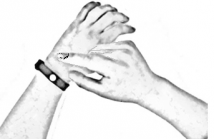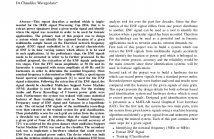
- Read more about Micro hand gesture recognition system using ultrasonic active sensing method
- Log in to post comments
We define micro hand gesture recognition system as which uses micro dynamic hand gestures within a time interval for classification and recognition to achieve human-machine interaction. Our Project Hug (Hand-Ultrasonic-Gesture), with ultrasonic active sensing, pulsed radar signal processing, and time-sequence pattern recognition is presented in this paper for micro hand gesture recognition. We leverage one single channel to detect both range and velocity precisely, reducing the hardware complexity.
- Categories:
 75 Views
75 Views
- Read more about IEEE Signal Processing Cup 2016 - Team Ravan
- Log in to post comments
This report describes a method which is implemented for the IEEE signal Processing Cup 2016, that is to extract power signatures from a given media signal and identify where the signal was recorded in order to be used for forensic applications.
The primary task of this project was to design a system which can identify the captured location of a given multimedia sample based on the Electrical network frequency signals (ENF) signal embedded in it.
Team_Ravan.pdf
- Categories:
 191 Views
191 Views- Read more about Partial Face Recognition: A Sparse Representation-based Approach
- Log in to post comments
Partial face recognition is a problem that often arises in practical settings and applications. We propose a sparse representation-based algorithm for this problem. Our method firstly trains a dictionary and the classifier parameters in a supervised dictionary learning framework and then aligns the partially observed test image and seeks for the sparse representation with respect to the training data alternatively to obtain its label. We also analyze the performance limit of sparse representation-based classification algorithms on partial observations.
- Categories:
 29 Views
29 Views- Read more about Lecture ICASSP 2016 Pierre Laffitte
- Log in to post comments
This presentation introduces a Deep Learning model that performs classification of the Audio Scene in the subway environment. The final goal is to detect Screams and Shouts for surveillance purposes. The model is a combination of Deep Belief Network and Deep Neural Network, (generatively pre-trained within the DBN framework and fine-tuned discriminatively within the DNN framework), and is trained on a novel database of pseudo-real signals collected in the Paris metro.
- Categories:
 13 Views
13 Views
- Read more about Discriminant Correlation Analysis for Feature Level Fusion with Application to Multimodal Biometrics
- Log in to post comments
In this paper, we present Discriminant Correlation Analysis (DCA), a feature level fusion technique that incorporates the class associations in correlation analysis of the feature sets. DCA performs an effective feature fusion by maximizing the pair-wise correlations across the two feature sets, and at the same time, eliminating the between-class correlations and restricting the correlations to be within classes.
- Categories:
 119 Views
119 Views- Read more about A NOVEL GENERALIZED ASSIGNMENT FRAMEWORK FOR THE CLASSIFICATION OF HYPERSPECTRAL IMAGE
- Log in to post comments
Recently, sparse representation based classification has been widely used in pattern recognition. Most of existing methods exploit the recovered representation coefficients to reconstruct the inputs, and the classwise reconstruction errors are used to identify the class of the sample based on the subspace assumption. Different from the reconstruction pipeline, an assignment framework is built on the representation coefficients in this paper.
- Categories:
 8 Views
8 Views- Read more about EPILEPTIFORM SPIKE DETECTION VIA CONVOLUTIONAL NEURAL NETWORKS
- Log in to post comments
- Categories:
 9 Views
9 Views- Read more about Characterization and Classification of Sonar Targets Using Ellipsoid Features
- Log in to post comments
We present a geometry-inspired characterization of
target response for active sonar that exploits similarity between
intra-class features to distinguish between different targets
against environmental objects such as a rock. Key innovation is to
represent feature manifolds as a set of ellipsoids, each of which
geometrically encompasses a unique physical characteristic of
the target’s response. We have demonstrated over experimental
field data that for a given target class, these feature ellipsoids
- Categories:
 25 Views
25 Views- Read more about Kernel-based low-rank feature extraction on a budget for Big data streams
- Log in to post comments
- Categories:
 16 Views
16 Views- Read more about 3D Object Modeling and Recognition via Online Hierarchical Pitman-Yor Process Mixture Learning
- Log in to post comments
- Categories:
 11 Views
11 Views